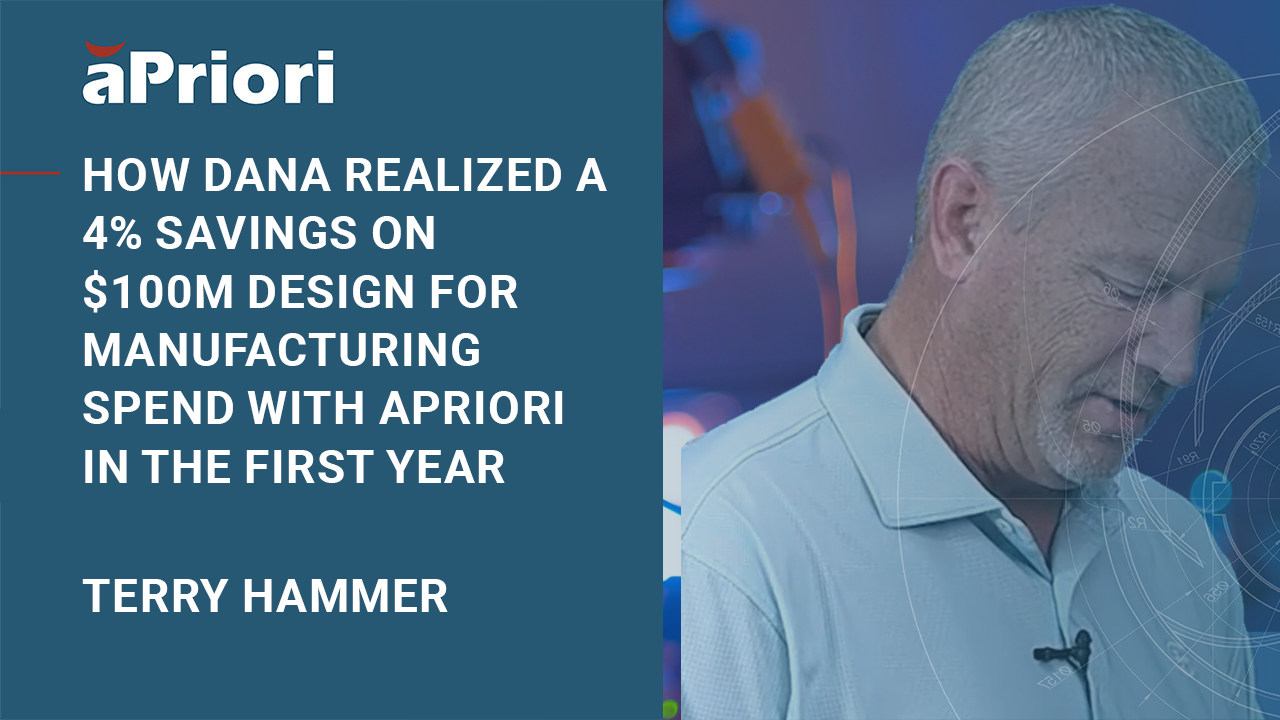Terry Hammer: I’m Terry Hammer. I’m the Vice President of Engineering for the Light Vehicle drive systems part of Dana Corporation. We are in the automotive sector, largely light truck, and heavy truck. We make axles, prop shafts, transmission, e-drive systems, motors and inverters.
Leah Archibald: And you only started engaging with aPriori about a year ago.
Terry Hammer: Yes.
Leah Archibald: What was the problem that you were trying to solve when you went to investigate a digital transformation, digital thread solution?
Terry Hammer: It was really Designed for Manufacturing. We started with the base concepts: what’s core or non-core to our business. What are we going to make or buy strategically and what regions of the world do we want to buy that in?
We really talked about cost when we talk about Design for Manufacturing and trying to take that knowledge from the manufacturing base and put it in the product, in the design engineer’s hands, so that they understand the relationship between what they put in the drawing, what they put in the specs, and the dollar figure associated to it.
I’ll try to give you a five second example. A park lock assembly: cost versus function. We looked at it in powdered metal technology: great cost, poor function. Then we went to forging, forging and machining. That’s the highest cost but guaranteed function. Then we went to fine blanking: cost comes down, function maybe, little risk. So then we did fine blanking plus key feature machining and said, okay, that is the best cost-function relationship to ensure performance matching up process.
Leah Archibald: That’s a powerful example of Design for Manufacturing, as well as an example of cost management.
Terry Hammer: Definitely. For our business, a round of development is roughly $3 million per component development cycle. So when you think of it: if I do a round of product development for 3 million bucks, and then somebody comes in and says, “Oh, it doesn’t match the manufacturing process, or that concept’s too expensive,” that’s 3 million bucks you threw away. You’ve got to do it again.
Leah Archibald: So have you saved $3 million in the past year since you implemented aPriori?
Terry Hammer: We started off really with the two-pronged approach. The first was: go show me ROI on current product.
We analyzed about $100 million dollars of spend. And we’ve shown 8% opportunity, which is a pretty good number. We’ve actually been able to realize about half of that. So $4 million out of $10 million. 4% return.
Leah Archibald: But that’s a payback for the software.
Terry Hammer: Oh, for sure.
Leah Archibald: That’s a payback for your software investment within the first year.
Terry Hammer: Yes, exactly.
Leah Archibald: In terms of a technological investment, that’s not bad.
Terry Hammer: For sure. It not only paid for the software, it paid for the people that we set aside to work on that software.
Leah Archibald: I like that.
Terry Hammer: So it truly paid for not only the software but the personnel cost. Dana hired one of your applied services guys for a year and basically pulled him into the organization and said, “Show us how to do it.” So we kind of jump-started our ROI through Applied Services, as well as your success management team.
Leah Archibald: So you are not even a year in. And I know it takes as much organizational change to get all the stakeholders on board as it does software adoption. Because the software can be pretty plug and play. There’s customization, but then getting your team on board often takes longer. What is your experience with that?
Terry Hammer: On both the VAVE side and the Design for Manufacturing side, and the “do it right the first time” side, as soon as people start to see the value – like the park lock example I talked about – then people say, “Okay, I get the method. I understand the process, I understand how much money it was worth, and I understand how fast it happened. I’m in.”


